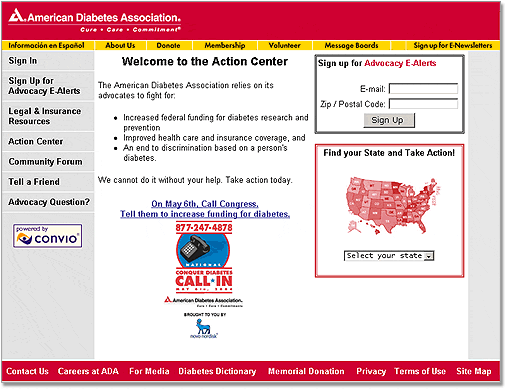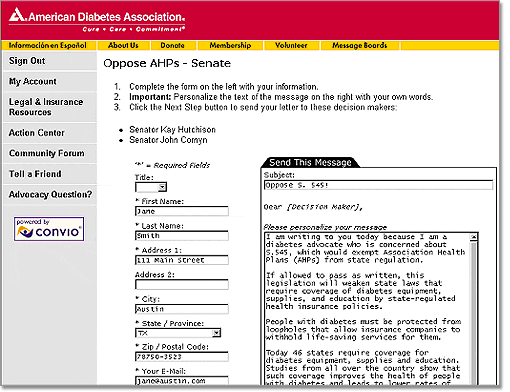|

May/June 2004
Building a Leading Online Advocacy Program: The American Diabetes Association's Strategy
The American Diabetes Association (ADA) Online
In addition to providing information and education online for people affected by diabetes, the ADA uses the Internet to promote volunteering, events, fundraising and advocacy. The ADA promotes advocacy for a variety of issues beyond funding for research and treatment, including insurance coverage, employment discrimination and social issues that affect quality of life for people with diabetes. As the primary vehicles for grassroots advocacy, the ADA's Web site and email communications are critical to the organization's success.
Challenge
Although the ADA realized the Internet's potential as an advocacy channel, its existing online systems were insufficient to support its goals. The organization could post action alerts online, but advocates still had to look up their legislators, manually copy a suggested letter to send to them and click through several online steps to email the correct lawmakers.
More significantly, the ADA lacked a system to track responses to action alerts, numbers of messages generated or activity levels and retention of online constituents. The organization had no way to determine the success of its online campaigns. The limited feedback the organization did receive from constituents indicated its online advocacy process was difficult and time-consuming.
Solution
To address these shortcomings, the ADA created an online advocacy center with Internet software from Convio. This solution supports sophisticated email communications, easier participation in online advocacy and a single online database that houses constituent data and tracks, segments and reports on constituent interests and activities with the organization. The solution has enabled the ADA to:
- segment advocates and target them with email communications based on their geographic locations and interests;
- track which advocates take action on which alerts, making it easier to acknowledge past actions and build ongoing relationships;
- gauge advocacy campaign effectiveness by measuring response rates and tracking responses based on different constituent segments; and
- use a single online database that makes it easy to cross-market advocacy activities to donors or fundraising appeals to activists.
Best Practices
The ADA increased involvement and participation of online constituents by using its advocacy center to employ best practices. These best practices include: 1. Build strong relationships online by personalizing advocate communications.
- Make it easy for constituents to register online and encourage them to volunteer additional information such as ZIP code and interests.
- Use email communications to provide updates about legislative issues that are relevant to the individual based on geographic location and interests.
- Provide a personalized Action Center page for each constituent that shows those alerts to which an advocate has responded and includes new, relevant action alerts.
2. Promote high levels of response through online advocacy tools.
- Give online advocates simple tools to send emails, letters or faxes to legislators.
- Automatically determine the correct legislator based on each constituent's ZIP code and populate Web forms to make responding quick and easy.
- Provide compelling reasons to respond, including a clear description of the pending legislation, potential impacts and the urgency involved.
- Enable local advocacy by sending state-specific alerts to targeted advocates.
3. Foster loyalty and encourage repeat action
- Acknowledge a constituent's past participation and actions, and communicate results of advocacy efforts frequently.
- Offer online advocates multiple ways to become involved with the organization beyond advocacy, e.g., donating, participating in a walk or run or other type of event, etc.

Fig.1: The ADA Action Center home page makes it easy for visitors to sign up, find information and forward the URL to friends. It also encourages involvement by linking to community forums and resources.

Fig.2: Action alert response pages automatically identify target legislators, provide a suggested message and send the appropriate format -- Web forms or emails -- to the legislator.
Results
The ADA now has 37,000 constituents registered to receive newsletters and both national and local action alerts via email. The Association's email file is growing by about 1,600 new registrants per month.
More than 48 percent of these registered advocates took action at least once and 23 percent took action multiple times in 2003 after receiving an action alert. Overall, ADA online advocates delivered nearly 97,500 emails, 101,000 faxes and 1,800 printed letters to decision-makers in response to action alerts.
The ADA also has achieved improved results from state-specific action alerts. Although the organization previously could not segment and personalize appeals, let alone measure responses, it now reports that action alerts have far outpaced typical online action alert response rates of up to three percent. By contrast, the ADA is driving action alert responses via email click-throughs that average 10 percent.
In addition, the ADA has an average of 3.8 responses per click-through on state action alerts -- constituents direct messages to almost four legislators every time they respond to an alert. This increases legislator exposure to issues facing the ADA. And, it is easy for constituents: they simply click on the names of target legislators that appear automatically on their Action Center pages.
By giving advocates a variety of ways to participate, the ADA keeps constituents interested in its activities; as a result, the organization has had success in cross-marketing events. For example, in early 2004, the ADA promoted its Call to Congress -- an event that occurs every other year on Capitol Hill -- to its online advocates. Within a few weeks, the event was oversubscribed -- despite the requirement that each individual pay his or her own way in addition to a registration fee. The ADA closed registration to the event, but is promoting a method for advocates to contact their legislators by phone while the event is taking place.
Summary
The ADA's approach to online advocacy demonstrates the power of online software and best practices for mobilizing advocates over the Internet. When used together for a comprehensive online strategy, today's advanced Internet tools and techniques can help any organization develop stronger online relationships with constituents and drive higher response rates to advocacy programs.
|




